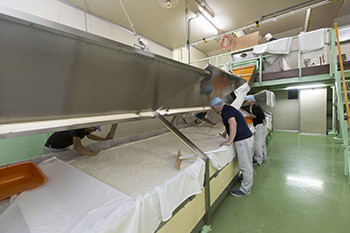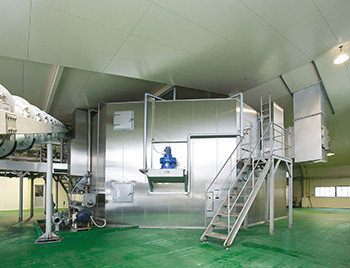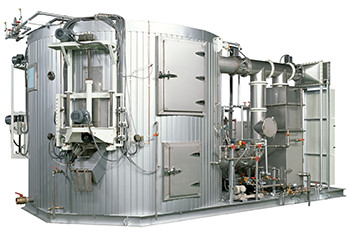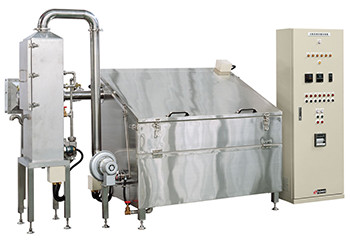Sei-kiku-ki・jidō sei-kiku-ki
- 【English】
- Kōji-making machine; automatic kōji machine
- 【Japanese】
- 製麹機・自動製麹機
The traditional “tray” method of making koji is extremely laborious and requires much skill and experience, so simplification and automation of the process proceeded from around 1960 , and many kinds of koji-making apparatus came into practical use. The basic principle of all kinds of apparatus is to control temperature and humidity by the blowing of air (adjusted to suitable levels of temperature and humidity) into the layer of koji, and extracting the heat which is created during sei-kiku. Air temperature is usually adjusted by blowing it through a warm water shower.
Machines can be divided into four types, according to the method of air flow.
- Interior ventilation style (内部通風式, naibu tsufu (the two “u”s of this second word long) shiki). Temperature- and humidity-adjusted air is blown through the layer of koji.
- Surface ventilation style (表面通風式, hyomen (long “o”) tsufu (both“u”s long) shiki). Temperature is controlled by blowing air onto the surface of the koji. (Also called “multi-stage thin-layered ventilation style”, 薄層多段通風方式, hakuso (long “o”) tadan tsufu hoshiki (long “o”)).
- Rotating drum system style (回転ドラム式, kaiten doramu shiki). The koji is circulated in a laterally-rotating cylindrical drum, into which temperature- and humidity-adjusted air is blown from one end.
- Non-ventilation style (無通風式, mu-tsufu shiki). By allowing evaporation of steam more or less evenly from both the top and bottom of the layer of koji, temperature is controlled without the use of fans or blowers.

seikiku ki

automatic koji maker1

automatic koji maker2

automatic koji maker3

